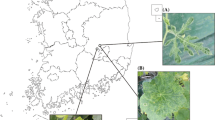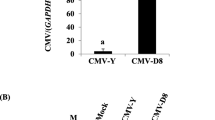Abstract
Two isolates of Youcai mosaic virus (YoMV) were obtained, and their full-length genomic sequences were determined. Full-length infectious cDNA clones of each isolate were generated in which the viral sequence was under the control of dual T7 and 35S promoters for both in vitro transcript production and agro-infiltration. Comparison of the predicted amino acid sequences of the encoded proteins revealed only four differences between the isolates: three in the RNA-dependent RNA polymerase (RdRp) (V383I and M492I in the 125-kDa protein and T1245M in the 182-kDa protein); and one in the overlapping region of the movement protein (MP) and coat protein (CP) genes, affecting only the N-terminal domain of CP (CP M17T). One of the isolates caused severe symptoms in Nicotiana benthamiana plants, while the other caused only mild symptoms. In order to identify the amino acid residues associated with symptom severity, chimeric constructs were generated by combining parts of the two infectious YoMV clones, and the symptoms in infected plants were compared to those induced by the parental isolates. This allowed us to conclude that the M17T substitution in the N-terminal domain of CP was responsible for the difference in symptom severity. The M17T variation was found to be unique among characterized YoMV isolates. A difference in potential post-translational modification resulting from the presence of a predicted casein kinase II phosphorylation site only in the CP of isolate HK2 may be responsible for the symptom differences.





Similar content being viewed by others
References
Lartey RT, Voss TC, Melcher U (1996) Tobamovirus evolution: gene overlaps, recombination, and taxonomic implications. Mol Biol Evol 13:1327–1338
Wei CT, Shen SL, Wang JL, Zhang CW, Zhu YG (1958) Mosaic disease of Chinese rape and other crucifers in eastern China. Acta Phytopathol Sin 2:94–111 (in Chinese)
Aguilar I, Sanchez F, Martin AM, Martinez-Herrera D, Ponz F (1996) Nucleotide sequence of Chinese rape mosaic virus (oilseed rape mosaic virus), a crucifer Tobamovirus infectious on Arabidopsis thaliana. Plant Mol Biol 30(1):191–197
Yamanaka T, Komatani H, Meshi T, Naito S, Ishikawa M, Ohno T (1998) Complete nucleotide sequence of the genomic RNA of tobacco mosaic virus strain Cg. Virus Genes 16(2):173–176
Zhu H, Hong J, Ye R, Chen J, Yu S, Adams MJ (2001) Sequence analysis shows that ribgrass mosaic virus Shanghai isolate (RMV-Sh) is closely related to Youcai mosaic virus. Arch Virol 146:1231–1238
Wetzel T, Njapo Ngangom HO, Chotewutmontri S, Krczal G (2006) Nucleotide sequence of a new isolate of ribgrass mosaic tobamovirus infecting impatiens New Guinea. Arch Virol 151:787–791
Fuji S, Mochizuki N, Fujinaga M, Ikeda M, Shinoda K, Uematsu S, Furuya H, Naito H, Fukumoto F (2007) Incidence of viruses in Alstroemeria plants cultivated in Japan and characterization of broad bean wilt virus-2, cucumber mosaic virus and Youcai mosaic virus. J Gen Plant Pathol 73:216–221
Ryu SY, Hong JS, Rhee SJ, Lee GP (2012) Brief report: Genome sequence and construction of an infectious cDNA clone of ribgrass mosaic virus from Chinese cabbage in Korea. Virus Genes 44:345–348
Wang DF, Zhang XM, Yang F, Niu YB (2016) Identification and analysis of complete genome sequence of Youcai mosaic virus Rehmannia glutinosa isolate in Shanxi. Acta Phytopathol Sin 46(5):598–604 (in Chinese)
Zhang SB, Liu J, Zhao ZB, Zheng LM, Zhang DY, Liu Y, Peng J (2016) First report of pepper (Capsicum annuum) as a natural host plant for Youcai mosaic virus. Plant Dis 100(2):541
Adams MJ, Antoniw JF, Kreuze J (2009) Virgaviridae: a new family of rod-shaped plant viruses. Arch Virol 154:1967–1972
Derrick PM, Carter SA, Nelson RS (1997) Mutation of the tobacco mosaic tobamovirus 126-and 183-kDa proteins: effects on phloem-dependent virus accumulation and synthesis of viral proteins. MPMI 10:589–596
Kobota K, Tsuda S, Tamai A, Meshi T (2003) Tomato mosaic virus replication protein suppress virus-targeted post-transcriptional gene silencing. J Virol 77:11016–11026
Kunihara Y, Inaba N, Kutsuna N, Takeda A, Tagami Y, Watanabe Y (2007) Binding of tobamovirus replication protein with small RNA duplexes. J Gen Virol 88:2347–2352
Mansilla C, Sanchez F, Padgett HS, Pogue GP, Ponz F (2009) Chimeras between oilseed rape mosaic virus and tobacco mosaic virus highlight the relevant role of the tobamoviral RdRp as pathogenicity determinant in several hosts. Mol Plant Pathol 10(1):59–68
Grdzelishvili VZ, Chapman SN, Dawson WO, Lewandowski DJ (2000) Mapping of the Tobacco mosaic virus movement protein and coat protein subgenomic RNA promoters in vivo. Virology 275(1):177–192
Ehrenfeld N, Canon P, Stange C, Medina C, Arce-Johnson P (2005) Tobamovirus coat protein CPCg induces an HR-like response in sensitive tobacco plants. Mol Cells 19:418–427
Ehrenfeld N, Gonzalez A, Canon P, Medina C, Perez-Acle T, Arce-Johnson P (2008) Structure-function relationship between the tobamovirus TMV-Cg coat protein and the HR-like response. J Gen Virol 89:809–817
Zhang C, Liu Y, Sun X, Qian W, Zhang D, Qiu B (2008) Characterization of a specific interaction between IP-L, a tobacco protein localized in the thylakoid membranes, and tomato mosaic virus coat protein. Biochem Biophys Res Commun 374(2008):253–257
Li Y, Wu MY, Song HH, Hu X, Qiu BS (2005) Identification of a tobacco protein interacting with tomato mosaic virus coat protein and facilitating long-distance movement. Arch Virol 150:1993–2008
Julve JM, Gandía A, Fernández-Del-Carmen A, Sarrion-Perdigones A, Castelijns B, Granell A, Orzaez D (2013) A coat-independent superinfection exclusion rapidly imposed in Nicotiana benthamiana cells by Tobacco mosaic virus is not prevented by depletion of the movement protein. Plant Mol Biol 81:553–564
Taraporewala ZF, Culver JN (1996) Identification of an elicitor active site within the three-dimensional structure of the tobacco mosaic tobamovirus coat protein. Plant Cell 8(2):169–178
Taraporewala ZF, Culver JN (1997) Structural and functional conservation of the tobamovirus coat protein elicitor active site. MPMI 10:597–604
Mizumoto H, Nakamura I, Shimomoto Y, Sawada H, Tomita R, Sekine KT, Kiba A, Nishiguchi M, Kobayashi K, Hikichi Y (2012) Amino acids in tobamovirus coat protein controlling pepper L(1a) gene-mediated resistance. Mol Plant Pathol 13:915–922
Morozov SY, Denisenko ON, Zelenina DA, Fedorkin ON, Solovyev AG, Maiss E, Casper R, Atabekov JG (1993) A novel open reading frame in tobacco mosaic virus genome coding for a putative small, positively charged protein. Biochimie 75(8):659–665
Erokhina TN, Lazareva EA, Richert-Pöggeler KR, Sheval EV, Solovyev AG, Morozov SY (2017) Subcellular localization and detection of tobacco mosaic virus ORF6 protein by immunoelectron microscopy. Biochemistry (Moscow) 82(1):60–66
Canto T, MacFarlane SA, Palukaitis P (2004) ORF6 of Tobacco mosaic virus is a determinant of viral pathogenicity in Nicotiana benthamiana. J Gen Virol 85(10):3123–3133
Gushchin V, Lukhovitskaya N, Andreev D, Wright K, Taliansky M, Solovyev A, Morozov S, MacFarlane S (2013) Dynamic localization of the tobamoviral ORF6 proteins involves distinct organellar compartments. J Gen Virol 94:230–240
Dorokhov YL, Shesuhukova EV, Komarova TV (2017) Tobamovirus 3′-terminal gene overlap may be a mechanism for within-host fitness improvement. Front Microbiol 8:851
Park CH, Ju HK, Han JY, Park JS, Kim IH, Seo EY, Kim J, Hammond J, Lim HS (2016) Complete nucleotide sequences and construction of full-length infectious cDNA clones of cucumber green mottle mosaic virus (CGMMV) in a versatile newly developed binary vector including both 35S and T7 promoters. Virus Genes 53(2):1–14
Lim HS, Bragg JN, Ganesan U, Ruzin S, Schichnes D, Lee MY, Vaira AM, Ryu KH, Hammond J, Jackson AO (2009) Subcellular localization of the barley stripe mosaic virus triple gene block proteins. J Virol 83:9432–9448
Kearse M, Moir R, Wilson A, Stones-Havas S, Cheung M, Sturrock S, Buxton S, Cooper A, Markowitz S, Duran C, Thierer T, Ashton B, Mentjies P, Drummond A (2012) Geneious Basic: an integrated and extendable desktop software platform for the organization and analysis of sequence data. Bioinformatics 28(12):1647–1649
Rost B, Yachdav G, Liu J (2004) The PredictProtein server. Nucleic Acids Res 32(web server issue):W321–W326
Goodin MM, Dietzgen GR, Schichnes D, Ruzin S, Jackson OA (2002) pGD vectors: versatile tools for the expression of green and red fluorescent protein fusions in agroinfiltrated plant leaves. Plant J 31(3):375–383
Han SH, Park JS, Han JY, Gong JS, Park CH, Kim JK, Seo EY, Domier LL, Hammond J, Lim HS (2017) New Korean isolates of pepper mild mottle virus (PMMoV) differ in symptom severity and subcellular localization of the 126 kDa protein. Virus Genes 53(3):434–445
Lim HS, Vaira AM, Domier LL, Lee SC, Kim HG, Hammond J (2010) Efficiency of VIGS and gene expression in a novel bipartite Potexvirus vector delivery system as a function of strength of TGB1 silencing suppression. Virology 402(1):149–163
Provvidenti R (1996) Turnip mosaic potyvirus. Virus Plants 1340–1343
Cheo CC (1962) Notes on viruses causing mosaic diseases of Chinese rape. Acta Phytopathol Sin 4:414–417 (in Chinese)
Park CY, Lee MA, Lee SH, Kim JS, Kim HG (2016) First report of Youcai mosaic virus in daisy fleabane (Erigeron annuus). Plant Dis 100(6):1250
Stange C, Matus JT, Elorza A, Arce-Johnson P (2004) Identification and characterization of a novel tobacco mosaic virus resistance N gene homologue in Nicotiana tabacum plants. Funct Plant Biol 31(2):149–158
Yamashita K, Fukui Y (2002) A tobamovirus isolated from Lisianthus, is similar to Youcai mosaic virus (YoMV). Jpn J Phytopathol 68(2):235
Acknowledgements
This work was supported by the National Research Foundation of Korea (NRF) grant funded by the Korea government (MEST) (no. NRF-2017R1A2B4005966).
Author information
Authors and Affiliations
Corresponding authors
Ethics declarations
Conflict of interest
The authors declare that they have no conflict of interest.
Ethical approval
This article does not contain any studies with human participants performed by any of the authors.
Additional information
Handling Editor: F. Murilo Zerbini.
Publisher's Note
Springer Nature remains neutral with regard to jurisdictional claims in published maps and institutional affiliations.
Electronic supplementary material
Below is the link to the electronic supplementary material.
705_2019_4222_MOESM2_ESM.tif
Supplementary material 2 Supplemental Fig. 1 (a) A schematic diagram of the procedure for cloning the YoMV CP into the PVX overexpression vector, using BamHI and MluI. YoMV HK1 and HK2 CPs were inserted separately. (b) Symptoms caused by PVX overexpression constructs (‘empty’ PVX, or PVX expressing HK1 CP = YoMV CP1, or HK2 CP = YoMV CP2) in systemically infected plants of N. tabacum cv. Xanthi and N. benthamiana (TIFF 13380 kb)
705_2019_4222_MOESM3_ESM.tif
Supplementary material 3 Supplemental Fig. 2 Multiple alignment of sequences of selected tobamovirus ORF6 and ORF6 orthologs. (a) Alignment of ORF6 and ORF6 orthologs showing sequence similarities between YoMV isolates and other tobamoviruses. Positions where at least three sequences share the same residue are highlighted in yellow; additional residues conserved between at least three sequences are highlighted in green, with blue, purple and red utilized if additional residue types are conserved in at least two sequences at a particular position within the alignment. The alignment was created using MUSCLE with the default parameters as implemented in Geneious v.11 (https://www.geneious.com, Kearse et al., 2012). (b) Predicted protein-protein binding sites and post-translational modification sites. Note that some sites overlap, and some sequences (KGMMV, ORSV, SFBV, TMGMV, TSAMV, and ZGMMV) have no predicted post-translational modification sites. None of the ORF6 or ORF6 ortholog proteins were predicted to include a nuclear localization signal (NLS). Predictions were generated by submission of the amino acid sequences to the PredictProtein server (https://predictprotein.org/; Rost et al., 2004). Predicted protein-protein binding and post-translational modification sites are indicated as follows: protein-protein binding site, grey highlighting; cyclic-AMP (cAMP)- and cGMP-dependent protein kinase phosphorylation site, red upper-case font; protein kinase C phosphorylation site, underlining; N-myristoylation site, blue font; amidation site, green lower-case font; casein kinase II phosphorylation site, gold font; N-glycosylation site, purple italic font; prenyl group binding site, red lower-case font (TIFF 3131 kb)
Rights and permissions
About this article
Cite this article
Ju, HK., Kim, IH., Hu, WX. et al. A single nucleotide change in the overlapping MP and CP reading frames results in differences in symptoms caused by two isolates of Youcai mosaic virus. Arch Virol 164, 1553–1565 (2019). https://doi.org/10.1007/s00705-019-04222-z
Received:
Accepted:
Published:
Issue Date:
DOI: https://doi.org/10.1007/s00705-019-04222-z




